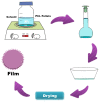PCL/Andiroba Oil (Carapa guianensis Aubl.) Hybrid Film for Wound Healing Applications
- PMID: 34069314
- PMCID: PMC8157046
- DOI: 10.3390/polym13101591
PCL/Andiroba Oil (Carapa guianensis Aubl.) Hybrid Film for Wound Healing Applications
Abstract
Developing a biomimetic material to wound care is an emerging need for the healing process. Poly (ε-caprolactone) (PCL) is a polymer with the necessary dressing's requirements often used in medicine. Their surface, physic-chemical and biological properties can be modified by adding bioactive compounds, such as andiroba seed oil (Carapa guianensis). This Amazonian natural plant has medicinal and pharmacological properties. For this purpose, PCL polymeric films incorporated with andiroba oil were investigated. The synthesis of hybrids materials was carried out in the solvent casting method. Thermal properties were evaluated using thermogravimetric analysis (TGA/DTGA) and differential scanning calorimetry (DSC). The solvent type on the surface and hydrophilicity of samples was studied using a scanning electron microscope (SEM). Additionally, contact angle measurements, functional groups analysis, fluid absorption capacity, and cell viability were performed. The results demonstrated the influences of andiroba oil under the morphology and thermal properties of the polymeric matrix; the hydrophilicity of the hybrid film obtained by acetic acid was reduced by 13%; the porosity decreased as the concentration of oil increased, but its higher thermal stability. The L929 cell line's proliferation was observed in all materials, and it presented nontoxic nature. It was demonstrated the ability of PCL hybrid film as a matrix for cell growth. Then, the materials were proved potential candidates for biomedical applications.
Keywords: andiroba oil; cell viability; polycaprolactone; polymer; wound healing.
Conflict of interest statement
The authors declare no conflict of interest. The funders had no role in the design of the study; in the collection, analyses, or interpretation of data; in the writing of the manuscript, or in the decision to publish the results.
Figures







Similar articles
-
Effects of andiroba oil (Carapa guianensis aublet) on the immune system in inflammation and wound healing: A scoping review.J Ethnopharmacol. 2024 Jun 12;327:118004. doi: 10.1016/j.jep.2024.118004. Epub 2024 Mar 1. J Ethnopharmacol. 2024. PMID: 38432579
-
Therapeutic effect of andiroba oil (Carapa guianensis Aubl.) against oral mucositis: an experimental study in golden Syrian hamsters.Clin Oral Investig. 2018 Jun;22(5):2069-2079. doi: 10.1007/s00784-017-2300-2. Epub 2017 Dec 18. Clin Oral Investig. 2018. PMID: 29256157
-
The Development and Characterization of an Andiroba Oil-Based Nanoemulsion (Carapa guianensis, Aubl.): Insights into Its Physico-Chemical Features and In Vitro Potential Healing Effects.Pharmaceutics. 2025 Apr 9;17(4):498. doi: 10.3390/pharmaceutics17040498. Pharmaceutics. 2025. PMID: 40284494 Free PMC article.
-
Therapeutic effects of andiroba (Carapa guianensis Aubl) oil, compared to low power laser, on oral mucositis in children underwent chemotherapy: A clinical study.J Ethnopharmacol. 2021 Jan 10;264:113365. doi: 10.1016/j.jep.2020.113365. Epub 2020 Sep 10. J Ethnopharmacol. 2021. PMID: 32920135 Clinical Trial.
-
The therapeutic properties of Carapa guianensis.Curr Pharm Des. 2014;20(6):850-6. doi: 10.2174/13816128113199990048. Curr Pharm Des. 2014. PMID: 23701562 Review.
Cited by
-
Comprehensive Characterization of Oils and Fats of Six Species from the Colombian Amazon Region with Industrial Potential.Biomolecules. 2023 Jun 13;13(6):985. doi: 10.3390/biom13060985. Biomolecules. 2023. PMID: 37371565 Free PMC article.
-
Chitosan Membrane Containing Copaiba Oil (Copaifera spp.) for Skin Wound Treatment.Polymers (Basel). 2021 Dec 23;14(1):35. doi: 10.3390/polym14010035. Polymers (Basel). 2021. PMID: 35012060 Free PMC article.
-
Polycaprolactone-Based Films Incorporated with Birch Tar-Thermal, Physicochemical, Antibacterial, and Biodegradable Properties.Foods. 2023 Nov 24;12(23):4244. doi: 10.3390/foods12234244. Foods. 2023. PMID: 38231687 Free PMC article.
-
Synthesis and Characterization of Natural Polymeric Membranes Composed of Chitosan, Green Banana Peel Extract and Andiroba Oil.Polymers (Basel). 2022 Mar 10;14(6):1105. doi: 10.3390/polym14061105. Polymers (Basel). 2022. PMID: 35335436 Free PMC article.
-
Poly (ε-caprolactone)-Based Scaffolds with Multizonal Architecture: Synthesis, Characterization, and In Vitro Tests.Polymers (Basel). 2023 Nov 14;15(22):4403. doi: 10.3390/polym15224403. Polymers (Basel). 2023. PMID: 38006127 Free PMC article.
References
-
- Wang X., Cheng F., Liu J., Smått J.-H., Gepperth D., Lastusaari M., Xu C., Hupa L. Biocomposites of Copper-Containing Mesoporous Bioactive Glass and Nanofibrillated Cellulose: Biocompatibility and Angiogenic Promotion in Chronic Wound Healing Application. Acta Biomater. 2016;46:286–298. doi: 10.1016/j.actbio.2016.09.021. - DOI - PubMed
-
- Zhang H., Peng M., Cheng T., Zhao P., Qiu L., Zhou J., Lu G., Chen J. Silver Nanoparticles-Doped Collagen-Alginate Antimicrobial Biocomposite as Potential Wound Dressing. J. Mater. Sci. 2018;53:14944–14952. doi: 10.1007/s10853-018-2710-9. - DOI
-
- Rogers V., George M., Luk A. Silicone Hydrogel Contact Lenses Having Improved Lubricity. Application n. 16/066,680. U.S. Patent. 2019 May 23;
Grants and funding
LinkOut - more resources
Full Text Sources
Miscellaneous

